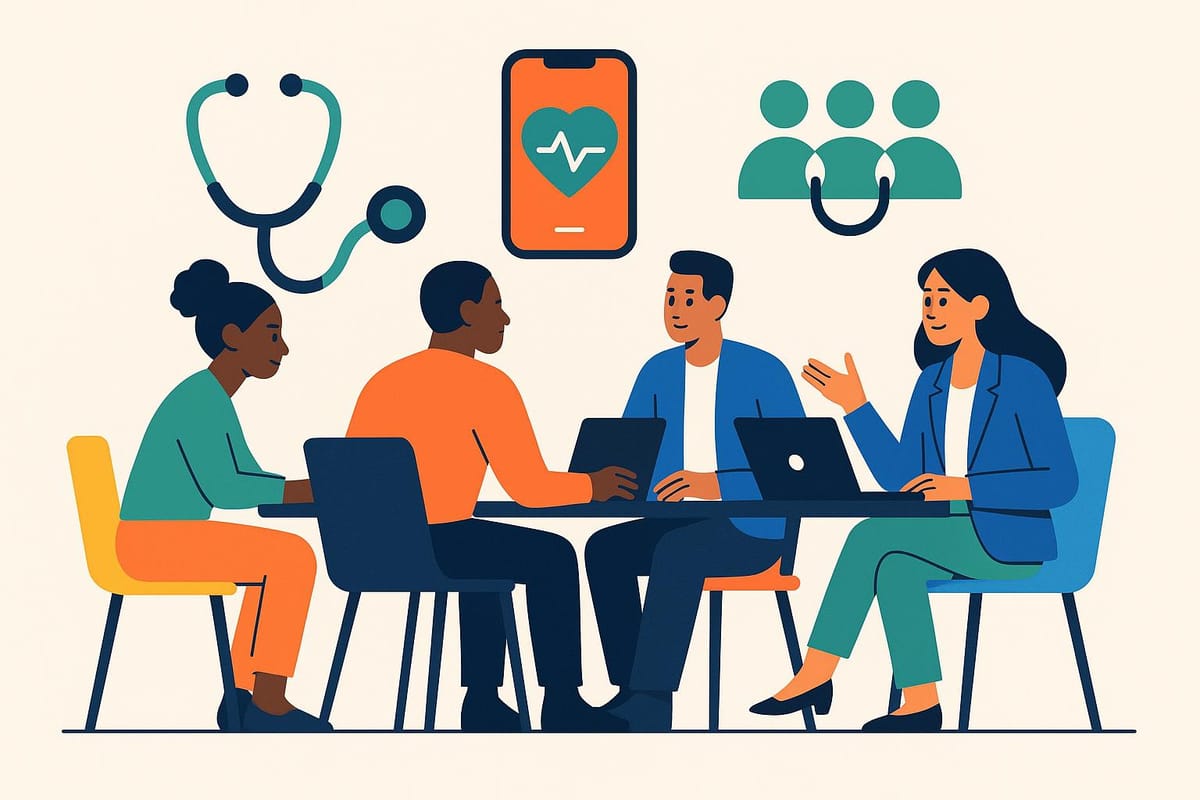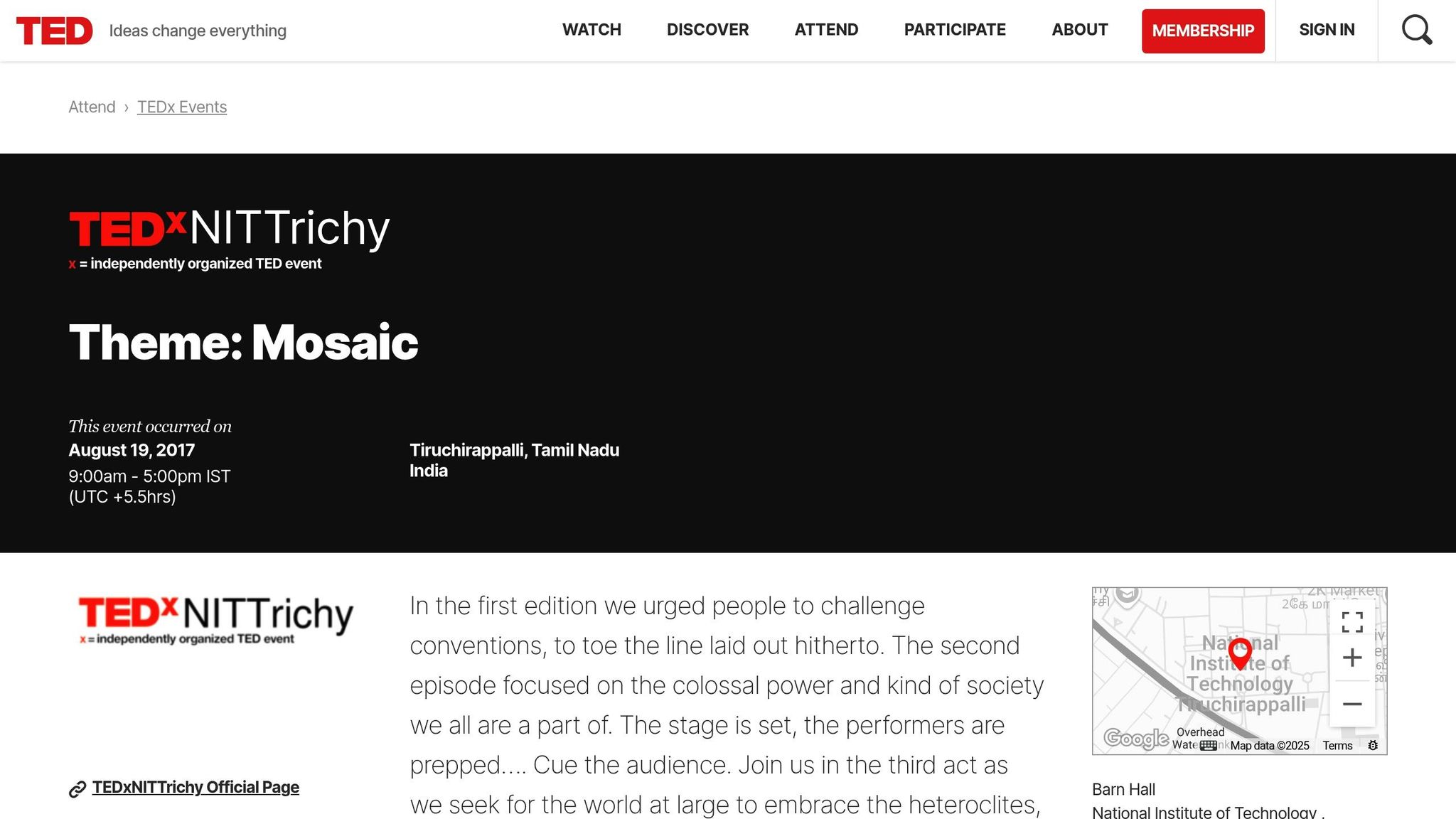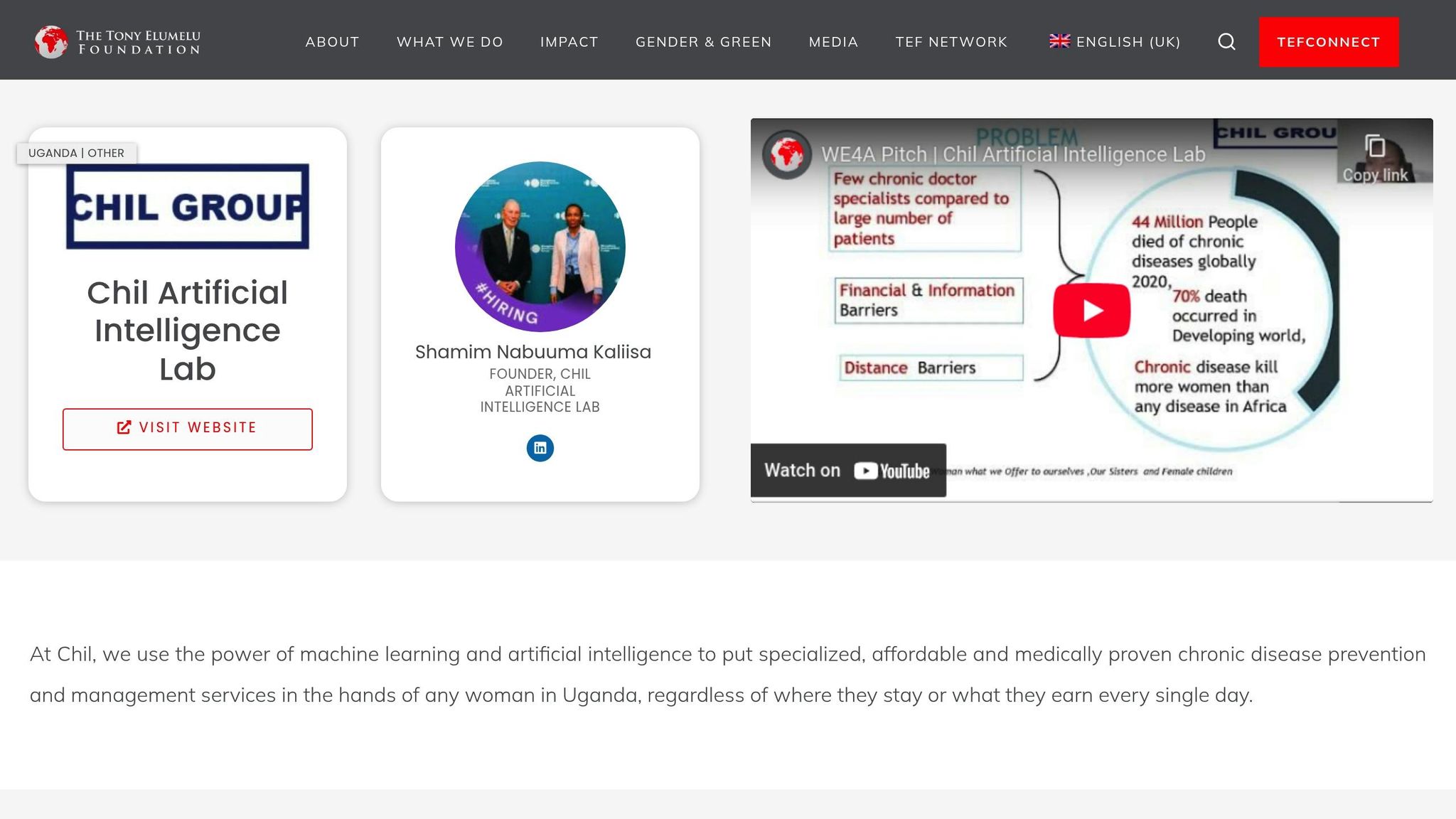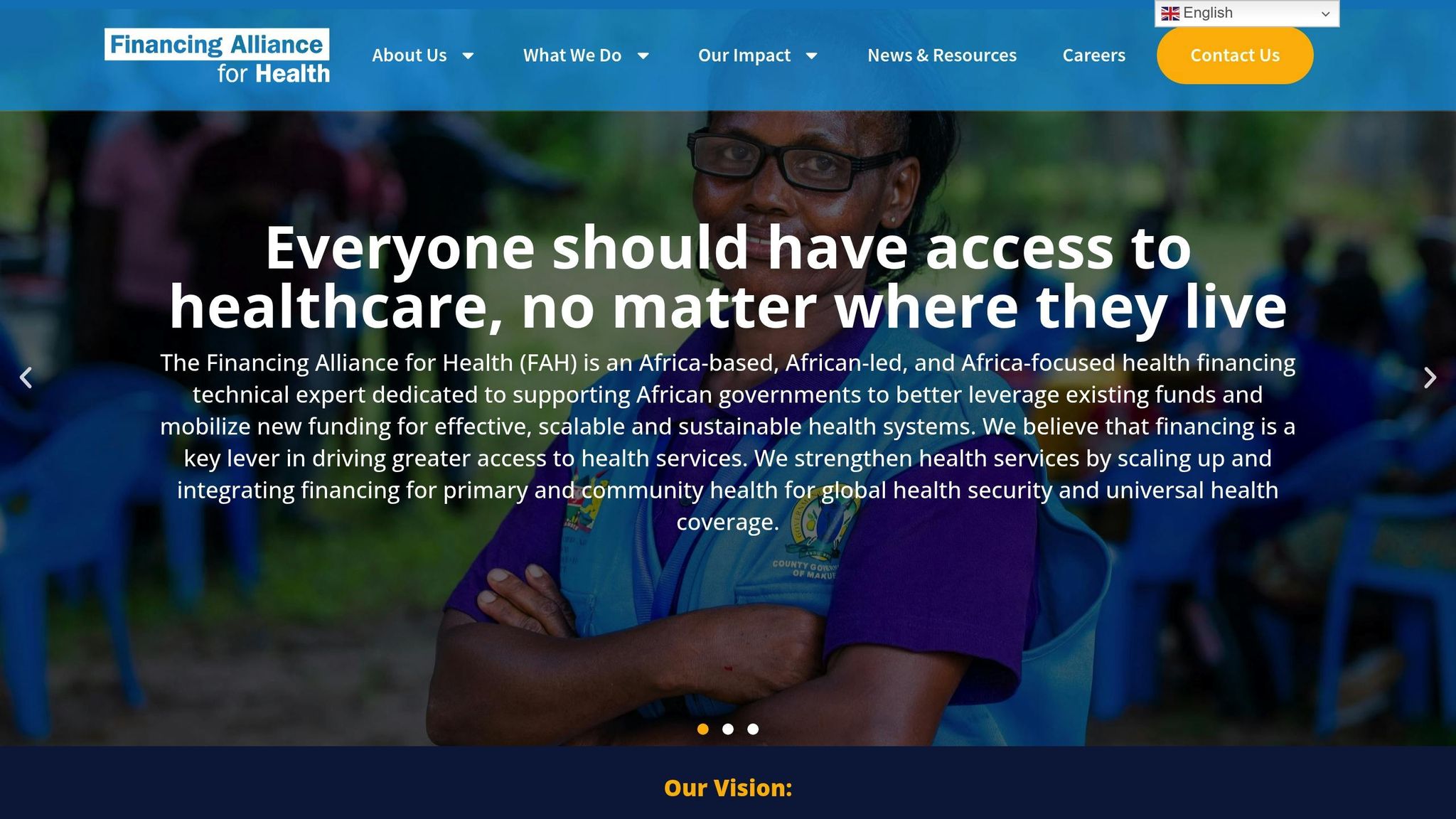Case Studies: Social Entrepreneurs Solving Healthcare Gaps
Explore how social entrepreneurs are innovating to close healthcare gaps through technology, community engagement, and strategic partnerships.

-
Key Focus Areas:
- Bringing healthcare to underserved rural areas through telehealth and mobile clinics.
- Reducing costs for essential medicines and services.
- Tackling workforce shortages with AI and technology.
- Improving safety and quality in low-resource settings.
-
Real Examples:
- We Care Solar: Distributed 8,350 solar suitcases, improving care for 13 million mothers and infants globally.
- Civica Rx: Pressured insulin manufacturers to cut prices by up to 75%.
- OneWorld Health: Operates 17 healthcare facilities across three countries, serving over 131,000 patients annually.
-
Core Strategies:
- Leveraging local knowledge and community input for tailored solutions.
- Using affordable, familiar technologies like WhatsApp for telemedicine.
- Partnering with governments and organizations to scale impact.
- Economic Impact: Closing health equity gaps in the U.S. could add $2.8 trillion to GDP by 2040.
Social entrepreneurship is proving that combining business principles with a mission-driven approach can address critical healthcare gaps, benefiting both communities and economies.
Viewing healthcare through the optics of social enterprise | Dr. P. Namperumalsamy | TEDxNITTrichy

How We Selected These Case Studies
To highlight effective healthcare solutions, we used a structured approach to select case studies. Our goal was to identify social entrepreneurs who had a measurable impact while addressing a wide range of healthcare challenges across different populations and regions. This deliberate process allowed us to explore varied examples showcasing creative responses to healthcare issues.
Standards for Choosing Case Studies
We relied on three main criteria to evaluate potential case studies. Each enterprise needed to meet the following requirements: it had to be founded by one or two entrepreneurs, address a healthcare problem, and show measurable results tied to its mission.
"Eligible enterprises met three criteria. Because the focus on this research is both on the enterprise and the individual, a sole architect was critical in achieving results. The following are inclusion criteria for the social entrepreneur and their enterprise: • Founded and established by one or two entrepreneurs • Created a solution to solve an issue in healthcare or medicine • Demonstrated impact with their respective mission" - Jonathan Feng and Jeffery R. Harris, Authors of "Being the Change: A Case Study of Five Social Entrepreneurs Improving Healthcare Equity"
The impact of each enterprise was a key factor in our selection. For example, We Care Solar, which began in 2010 in Berkeley, California, distributed 8,350 solar suitcases by 2023, trained 35,000 healthcare workers, and improved care for an estimated 13 million mothers and infants by providing 276 million hours of medical lighting globally.
Innovative approaches also influenced our choices. Civica Rx, established in 2018 in Lehi, Utah, exemplifies this with its 2022 announcement to produce an insulin biosimilar by 2024. This move pressured major pharmaceutical companies - Eli Lilly, Novo Nordisk, and Sanofi - to reduce their insulin prices by 70%, 75%, and 65%, respectively.
We also considered growth potential and sustainability. For instance, OneWorld Health, founded in 2011 in Charleston, South Carolina, developed a model to break even within two years while providing essential healthcare. By 2022, the organization operated 17 healthcare facilities staffed by 273 professionals, serving 131,693 patients across Nicaragua, Honduras, and Uganda.
Another critical criterion was the connection to U.S. healthcare challenges. By focusing on U.S.-based enterprises with international reach, we highlighted solutions that are relevant both domestically and globally.
Including Different Types of Cases
To ensure a broad perspective, we prioritized diversity in geography, population, and economic contexts. This helped us showcase a wide range of social entrepreneurship efforts in healthcare.
Geographical diversity was a key aspect of our selection, with representation spanning regions like Africa, Asia, Central and South America, Europe, and the United States.
Population diversity was another important factor. We included enterprises serving different demographics, from survivors of gender-based violence in urban New York to mothers in rural African communities. For example, the PurpLE Health Foundation, founded in 2019 in New York City, provided over 1,500 hours of free healthcare to gender-based violence survivors and trained more than 10,000 healthcare providers by 2023.
We also ensured variation in economic backgrounds. Both for-profit and non-profit organizations were included to highlight how different financial models can achieve meaningful results. Partners for World Health, founded in 2009 in Portland, Maine, collects and redistributes usable medical supplies from U.S. hospitals. In 2022, the organization shipped 17 containers of supplies (valued at $250,000 each) and 4 air shipments, totaling 500,000 pounds, to eight countries.
Finally, we included a broad range of healthcare challenges. The selected enterprises address issues like rural healthcare access, pharmaceutical costs, maternal health, gender-based violence, and medical supply waste. This variety demonstrates how different approaches can solve unique healthcare problems.
While the missions, locations, and models of these enterprises differ, they share common traits that contribute to their success. By examining this diversity, readers can better understand the various ways social entrepreneurs create meaningful healthcare solutions while identifying the shared factors that drive their achievements across different contexts.
Case Studies of Social Entrepreneurs Solving Healthcare Problems
These case studies highlight how social entrepreneurs tackle complex healthcare challenges by using technology, mobilizing community resources, and amplifying local voices in shaping health services.
Chil AI Lab: Bringing Specialist Care to Rural Areas

Chil AI Lab is part of a growing trend in healthcare technology aimed at improving access to specialist care for rural communities through artificial intelligence. Although specific impact data for Chil AI Lab isn't available, their AI-driven platform connects rural patients to specialist insights, offering support in diagnosis and treatment planning.
This approach addresses a significant issue: the lack of specialists in rural areas. By using AI to assist with medical diagnoses and treatment plans, Chil AI Lab presents an alternative to the ongoing struggle of recruiting and retaining healthcare specialists in low-demand regions. On a broader scale, organizations like the Financing Alliance for Health are also working to strengthen community health systems through strategic partnerships and funding solutions.
Financing Alliance for Health: Strengthening Community Health Systems

The Financing Alliance for Health (FAH) focuses on mobilizing resources and funding to support community health initiatives. To date, FAH has secured over $297 million in funding across 16 countries, worked with 22 governments, and contributed to raising more than $200 million for large-scale community health programs. Their efforts have also helped train nearly 3,000 stakeholders through a 9-month fellowship program.
FAH’s strategy is rooted in long-term collaborations with governments. By embedding health financing experts within Ministries of Health for 3–5 years, they’ve established operations in seven countries, including Kenya, Zambia, Ethiopia, Senegal, and Mali. Their work has also led to the policy recognition of over 415,000 Community Health Workers (CHWs), ensuring their roles are officially acknowledged and supported.
"Working with FAH has been transformative for our policy and planning efforts. Their technical support and collaborative approach have significantly strengthened our health financing strategies and improved the alignment of our health programs with national priorities. The partnership has enabled us to make data-driven decisions and implement effective reforms, which are crucial for advancing our health system."
– Ms. Madrine Mbuta, Director of Policy and Planning, Ministry of Health, Zambia
In Kenya’s Makueni County, FAH introduced the CHUSLA model, which provides financial support to CHWs through a revolving loan scheme. This initiative not only boosts motivation among CHWs but also ensures program sustainability. Additionally, FAH has helped mobilize over $22.7 million in domestic resources by co-developing policies that unlock local funding. This approach offers valuable lessons for American community health programs looking to diversify funding streams and build stronger relationships with local governments.
"The Financing Alliance for Health has been more than just a partner; they've been a true ally in our mission to bring lifesaving healthcare to the most vulnerable in our communities. Their unwavering support and commitment in shaping our policies and strategies as well as in helping us advocate for increased resource mobilization have helped us turn challenges into opportunities, enabling our CHPs to reach families who once thought quality care was out of reach. Together, we are not just building systems; we are restoring hope and changing lives."
– Dr. Nelson Muriu, Director of Health Services, Nyeri County, Kenya
Another notable example of community-driven healthcare innovation comes from SESH, which reimagines sexual health services.
SESH: Redesigning Sexual Health Services with Community Input

Social Entrepreneurship to Spur Health (SESH) takes a community-centered approach to designing sexual health services. Instead of relying on traditional, top-down health promotion methods, SESH invites community members to shape health interventions, making them more relevant to underserved populations.
The heart of SESH’s strategy lies in its crowdsourcing model. Through contests, the organization gathers community-designed health promotion messages on topics like HIV testing, condom use, and sexual health awareness.
Dr. Joseph Tucker, co-founder of SESH, describes their approach:
"SESH is really coming up with an entirely new model for delivering and designing sexual health services. The traditional model has been very top-down where experts and professionals design media campaigns and resources to promote testing but the idea of SESH is to really turn that upside down and think about a community-based, a community-driven response to sexual health services."
– Dr. Joseph Tucker, Co-founder, SESH
In the U.S., SESH’s model has the potential to address gaps in care for marginalized groups, such as LGBTQ+ individuals, communities of color, and rural populations. By involving these communities directly in the design process, SESH ensures that services are not only more inclusive but also cost-effective compared to traditional campaigns. The result is higher engagement and a more meaningful educational experience.
Together, these case studies showcase how focused strategies - whether through technology, partnerships, or grassroots participation - can create impactful solutions to healthcare challenges. Social entrepreneurs are finding new ways to bridge gaps and bring care to those who need it most.
Comparing Different Case Study Methods
The social entrepreneurs featured in these case studies have each taken unique paths to tackle healthcare challenges. By examining approaches like those of FAH and SESH, emerging innovators can better determine which strategies align with their objectives and local needs.
For example, the Financing Alliance for Health (FAH) operates on a broad, systemic level, collaborating with governments to enhance health financing and policy frameworks. Meanwhile, Chil AI Lab and SESH represent more localized efforts. Chil AI Lab is described as a technology-driven platform aimed at improving rural healthcare access, while SESH focuses on a community-led model addressing sexual health needs. These contrasting methods highlight how different approaches suit different contexts.
The choice between these models often comes down to priorities: technology platforms like Chil AI Lab aim for rapid scalability, while community-driven initiatives like SESH prioritize deep, localized engagement. On the other hand, systemic interventions, such as those championed by FAH, can have far-reaching impacts but require long-term commitment and strategic planning.
Table: Comparing Case Study Models
| Element | Chil AI Lab (as outlined) | Financing Alliance for Health | SESH (as outlined) |
|---|---|---|---|
| Model Type | Technology-driven platform for rural healthcare access | Africa-based, African-led health financing expert supporting government systems for universal health coverage | Community-led approach to sexual health solutions (as outlined) |
| Methods | Not specified | 3–5 year partnerships with governments; policy development; resource mobilization; fellowship programs | Not specified |
| Measurable Results | Not specified | Over $297M mobilized; policies co-developed that mobilized over $22.7M in domestic resources; over 2,972 stakeholders upskilled | Not specified |
| Growth Potential | Not specified | Recognized by key international platforms, indicating high potential for scale | Not specified |
| Primary Obstacles | Not specified | Political instability, complex government systems, and sustained funding needs | Not specified |
| US Healthcare Application | Not specified | Principles of health financing and government partnership could inform strategies for underserved US communities | Not specified |
Note: Specific details for Chil AI Lab and SESH were not available in the reviewed sources.
The timelines for impact also vary significantly. FAH’s systemic interventions often unfold over several years, reflecting the time required for policy and structural changes. Technology platforms demand ongoing maintenance and updates, while community-led models like SESH depend on consistent local involvement, which may require external support to remain viable over time.
Sustainability strategies differ as well. FAH focuses on building long-term government capacity and enacting durable policies. A quote from Ms. Madrine Mbuta, Director of Policy and Planning at Zambia’s Ministry of Health, captures this impact:
"Working with FAH has been transformative for our policy and planning efforts. Their technical support and collaborative approach have significantly strengthened our health financing strategies and improved the alignment of our health programs with national priorities. The partnership has enabled us to make data-driven decisions and implement effective reforms, which are crucial for advancing our health system." – Ms. Madrine Mbuta, Director of Policy and Planning-MoH, Zambia
When it comes to measuring success, each model has its own approach. Technology platforms often focus on tracking user engagement and outcomes, systemic models like FAH require complex metrics to evaluate policy changes, and community-driven efforts combine both quantitative and qualitative data to capture their impact.
The risks also vary. Systemic models must navigate shifting government priorities, while community-led initiatives hinge on sustained local leadership. Technology-driven solutions, meanwhile, face challenges like maintaining relevance and adapting to changing user needs.
In practice, many social entrepreneurs blend these approaches - combining technology, community involvement, and systemic reforms to create solutions that are both scalable and resilient. This hybrid mindset often proves essential for addressing healthcare gaps effectively.
Key Lessons for New Social Entrepreneurs
The case studies highlighted here reveal essential strategies for social entrepreneurs aiming to transform healthcare. Whether in Kenya, Pakistan, or the United States, these approaches provide practical insights for those looking to make an impact.
Using Technology to Improve Access
Technology has proven to be a game-changer in addressing healthcare gaps, but it’s not about chasing the latest innovations. The real power lies in leveraging affordable and familiar tools to meet healthcare needs.
Take Penda Health in Kenya, for example. They’ve used WhatsApp for telemedicine while running 19 centers. Their subscription-based model encourages patients to see healthcare as an ongoing service rather than a one-time visit, a system they’ve successfully maintained since 2012.
Similarly, Pakistan’s DoctHERs bridges the gap between underserved patients and over 300,000 female healthcare workers using simple tools like WhatsApp and phone calls. By sticking to technology that’s already familiar, they’ve broken through sociocultural barriers.
"While technology is a great democratizer of healthcare, it is not sufficient. It does require that empathetic touch, the healing power of human intervention." – Dr. Asher Hasan, Co-Founder and CEO of DoctHERs
The balance of tech and human connection is key. AccuHealth in Chile demonstrates this with its AI-powered chronic disease monitoring system. When patients show abnormal readings, health coaches step in within hours, improving health outcomes like a 1.5-point reduction in A1c levels for diabetics and cutting inpatient visits by 32%.
In Kenya, Access Afya launched its Curafa platform in 2023, enabling local healthcare workers to manage affordable franchise clinics. Their virtual consultation app works on any phone, making healthcare more accessible to a broader audience.
"Our virtual care further increases access and enables individuals to be active participants in their healthcare, [by making it] accessible through multiple channels for any phone user." – Dr. Daphne Ngunjiri, CEO of Access Afya
The takeaway? Focus on affordability and usability. Solutions that fit seamlessly into people’s daily digital habits are more likely to succeed. And beyond technology, partnerships play a critical role in scaling these solutions.
Creating Partnerships Across Different Sectors
No single organization can solve healthcare challenges alone. Partnerships across sectors - government, private companies, nonprofits, and community groups - offer the resources and reach needed to make a larger impact.
For example, Petaluma Health Center tackled transportation barriers by partnering with local agencies and using grant funds to provide Lyft rides for patients.
The Innovation Lab at Washington University worked with startup XCo and the Cardiovascular Division to develop a remote heart failure monitoring platform. By involving clinicians and patients in iterative prototyping, they ensured the product addressed real-world needs.
"I consider it a real success and a bit of a blueprint for how even other startups could be partnering early on." – XCo Participant
In North Carolina, Access Healthcare partnered with African Methodist Episcopal (AME) Church leaders to host live cardiovascular health sessions. They also worked with policymakers to address food deserts and transportation issues.
Trust is the foundation of any successful partnership. As one participant from the Innovation Lab noted:
"At this point [when making the initial investments in XCo], the trust that I need to have in the [XCo CEO] and that he needed to have in me [Lab] was foundational. If it were purely transactional or one of us was really trying to screw the other, I think it would have fallen apart at this stage." – Innovation Lab Participant
For new entrepreneurs, the key is to evaluate potential partners thoroughly. Visit their facilities, understand their operations, and discuss mutual goals. Strong partnerships thrive on shared benefits and deep community involvement.
Including Communities in Solution Design
The most enduring healthcare solutions are those created with communities, not for them. When communities are co-creators, they take ownership of the initiatives, ensuring long-term success.
For instance, DePaul Community Health Centers in New Orleans collaborated with local organizations to prevent atrial fibrillation. They worked with the American Heart Association for educational materials, the New Orleans Recreation Development Commission for exercise access, and Sankofa Community Development Corporation for healthy food options.
The Rural Opportunity Institute involved local residents as co-designers, providing training and scholarships valued at over $200,000. This approach led to a 57% reduction in anxiety symptoms among participants.
About Fresh, which addresses food insecurity, serves over 5,000 patients and processes more than $1 million in funds across 475 grocery retailers. By starting with a mobile food truck and evolving to the Fresh Connect platform, they’ve enabled healthcare providers to prescribe food as medicine, while respecting local dietary preferences.
Community engagement also means meeting people where they are. DLIVE (Detroit Life is Valuable Every Day) has reduced trauma recidivism to less than 6%, compared to a historical rate of 44%. Over 80% of participants have found jobs or enrolled in education programs. Their success lies in tailoring solutions to individual needs with trauma-informed strategies.
"The other one that always surprises me is the social isolation question. Then I say, 'wait a second, you wrote here that you only have one outside contact per week.' […] We don't think to necessarily ask because we're doing a 15 minute medical care visit. [Social isolation and transportation] are things that I feel like I've been both surprised by, and have been able to effect change for individuals where we find that. Those are actually things that we can overcome." – PHC Provider
To make these efforts work, it’s crucial to involve community members and front-line staff in every step, from planning to implementation. Simplifying reports for partners and maintaining open communication also helps build trust and ensures that solutions address real priorities. This collaborative approach leads to healthcare systems that are not only effective but also deeply rooted in the needs of the communities they serve.
Why Ongoing Learning Matters for Social Entrepreneurs
Healthcare social entrepreneurs are in a constant state of learning. With shifting regulations, new technologies, and evolving community needs, staying informed isn't just helpful - it's essential. For instance, clinical experts often need to develop business skills, while technical experts must improve their ability to engage with communities. In 2023, healthcare venture capital raised an impressive $19 billion, yet nearly 15% of hospital patients still faced adverse events, with 10–20% of those linked to medication errors. These statistics highlight just how crucial continuous learning is in navigating the ever-changing healthcare landscape.
"Entrepreneurial education makes it possible to establish training environments where students join as 'novices', develop skills and undergo experiences that help them build capable profiles and prepare for their professional careers in today's economy."
- Juhi M Raut and Abhishek U Joshi
To meet these challenges, skills in business management, financial planning, marketing, regulatory compliance, and systems thinking are indispensable. Recognizing this need, the Government of India introduced a policy for Biomedical Innovation and Entrepreneurship in 2022. As past case studies show, ongoing education strengthens the strategies that lead to meaningful healthcare solutions.
Upskillist: Training Entrepreneurs Through Education

Meeting the demand for continuous education, platforms like Upskillist play a key role. Upskillist provides accessible, expert-designed courses that empower social entrepreneurs to make a lasting impact. With a 7-day free trial, learners can explore premium courses and AI-driven tools without any upfront financial commitment - an ideal opportunity for aspiring healthcare innovators.
Upskillist’s focus is on goal-oriented learning. Its programs are designed to help entrepreneurs launch or grow ventures that drive social change. Created by industry experts, the courses emphasize practical knowledge and real-world application. Tools like Compass AI and Pathfinder personalize learning paths to meet individual needs, while flexible scheduling and lifetime access make it easier for busy professionals to keep their skills up to date as their ventures grow.
Building Skills That Create Real Impact
Healthcare social entrepreneurs need more than just passion - they require strong business skills to ensure their ventures are sustainable. This includes expertise in financial planning, market analysis, and human resource management. These skills help avoid common pitfalls and create steady revenue streams.
Innovation and systems thinking are equally important. Entrepreneurs must be able to assess complex systems and develop creative solutions that address service gaps. At the same time, prioritizing community engagement and equity ensures that solutions remain inclusive and responsive to diverse populations.
Keeping up with licensing requirements, compliance standards, and policy changes is another key area where ongoing education proves invaluable. Staying informed not only helps entrepreneurs adapt to new regulations but also equips them with the advocacy skills needed to shape policy for the better.
"The education gap is significant, and many nursing schools need more business management, financial planning and marketing coursework, as knowledge of these areas is essential for entrepreneurial success."
- Carolina S Meintjies and Jeanette E Maritz
In today’s healthcare landscape, digital literacy and data analytics are becoming increasingly important. These skills not only improve operational efficiency but also help protect patient privacy. Balancing financial sustainability with social impact is no small feat, but it’s a challenge that ongoing education helps entrepreneurs tackle head-on.
Ultimately, social entrepreneurs who commit to continuous learning are better equipped to address healthcare challenges. By evolving their skills, they remain adaptable and focused on creating solutions that deliver meaningful social change.
Conclusion: Creating Change Through Social Entrepreneurship
Real-world examples reveal how social entrepreneurship can effectively address healthcare gaps. Initiatives like Solar Suitcases and Civica Rx's efforts to tackle insulin pricing illustrate how fresh ideas can lead to meaningful, systemic change in diverse communities.
From these examples, three key factors for success stand out. First, many innovative solutions stem from personal experiences - moments when entrepreneurs witness healthcare inequities up close. For instance, Elizabeth McClellan's realization of medical supply waste and We Care Solar's collaboration with health ministries show how personal insights, combined with strategic partnerships, can create powerful change.
Second, adaptability plays a crucial role. The healthcare landscape is constantly evolving, with venture capital investments in the sector reaching $19 billion in 2023. Entrepreneurs must navigate regulatory changes, emerging technologies, and shifting community needs. OneWorld Health, led by Matt Alexander, exemplifies this adaptability. By establishing 17 healthcare facilities that serve over 131,000 patients and creating self-sustaining business models that reach financial stability within two years, the organization demonstrates how flexibility can lead to long-term success.
Community engagement is another cornerstone of successful healthcare social entrepreneurship. By involving communities as active participants in the process, solutions become not only more effective but also sustainable.
"Social entrepreneurs prioritize the needs of marginalized or underserved communities and strive to create a more equitable and just society."
The growing recognition of social entrepreneurship highlights a shift in how healthcare challenges are approached. Once considered niche, these efforts are now seen as central to innovation in healthcare. Policymakers and corporations increasingly acknowledge the role of entrepreneurs in meeting global goals for equity and sustainability.
"For healthcare entrepreneurs to achieve their targeted health outcomes as well as their operational and profitability outcomes, all stakeholders need to work together."
These examples underline the strategies that drive success: identifying needs through firsthand experiences, innovating with limited resources, building strong partnerships, and committing to continuous learning. Equity and sustainability remain at the heart of these efforts. Programs like Upskillist emphasize how ongoing education strengthens these transformative initiatives.
Altogether, these case studies provide a clear framework for reimagining healthcare through entrepreneurial approaches. Social entrepreneurship offers a practical path for addressing gaps that traditional systems often fail to fill, creating lasting benefits for underserved populations worldwide.
FAQs
How do social entrepreneurs use technology to improve healthcare access in underserved communities?
Social entrepreneurs are using technology as a powerful tool to address healthcare challenges in underserved areas. With solutions like telehealth platforms, mobile clinics, and AI-driven diagnostics, they’re breaking down barriers to care. These tools enable remote consultations, bring essential medical services to rural regions, and enhance the accuracy of diagnoses.
By tackling issues like a shortage of healthcare providers and the difficulties posed by geographic isolation, these advancements are helping make quality healthcare more accessible and affordable for communities that have long been overlooked.
What factors drive the success of social entrepreneurship in addressing healthcare challenges?
The success of social entrepreneurship in healthcare often depends on effective leadership, a committed team, and a legal and regulatory framework that promotes innovation. Entrepreneurs who embrace innovative approaches such as telemedicine or remote patient monitoring have the potential to greatly enhance both access to care and patient outcomes.
Just as crucial are determination and a genuine drive to make a difference. Building scalable models allows for lasting impact and flexibility across a wide range of healthcare environments. By prioritizing these factors, social entrepreneurs can play a key role in addressing gaps in healthcare access and affordability.
How do partnerships across sectors boost the impact of social entrepreneurship in healthcare?
Cross-sector partnerships play a powerful role in boosting the impact of social entrepreneurship in healthcare. By bringing together the knowledge, resources, and viewpoints of various stakeholders - like healthcare providers, community organizations, and social services - these partnerships tackle tough issues such as access to care, affordability, and health equity more effectively.
When these groups collaborate, they align their goals, simplify how services are delivered, and strengthen the overall healthcare system. The result? Lower costs, better outcomes, and long-term solutions that serve underserved communities while promoting healthier lives across the board.

